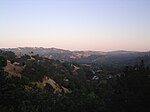Lamorinda AVA
Lamorinda AVA is an American Viticultural Area in the San Francisco Bay Area located due east of the Berkeley Hills in Contra Costa County encompassing the region around the cities of Lafayette, Moraga and Orinda. The name Lamorinda is a portmanteau from the names of the three locales defining the region: Lafayette, Moraga, and Orinda. The AVA is a sub-region within the existing San Francisco Bay AVA and the larger, multicounty Central Coast AVA stretching approximately 30,000 acres (47 sq mi) with 46 commercially-producing vineyards that cover approximately 139 acres (56 ha). The USDA plant hardiness zone for the AVA is 9b. The AVA was proposed as the growers in the area found the wider San Francisco Bay and Central Coast AVA titles too generic and not indicative of its terroir. The Lamorinda AVA was officially established in February 2016 by the Alcohol and Tobacco Tax and Trade Bureau (TTB).
Excerpt from the Wikipedia article Lamorinda AVA (License: CC BY-SA 3.0, Authors).Lamorinda AVA
Saint Mary's Road,
Geographical coordinates (GPS) Address Nearby Places Show on map
Geographical coordinates (GPS)
| Latitude | Longitude |
|---|---|
| N 37.88576 ° | E -122.11802 ° |
Address
Saint Mary's Road 3598
94549 , Burton Valley
California, United States
Open on Google Maps




